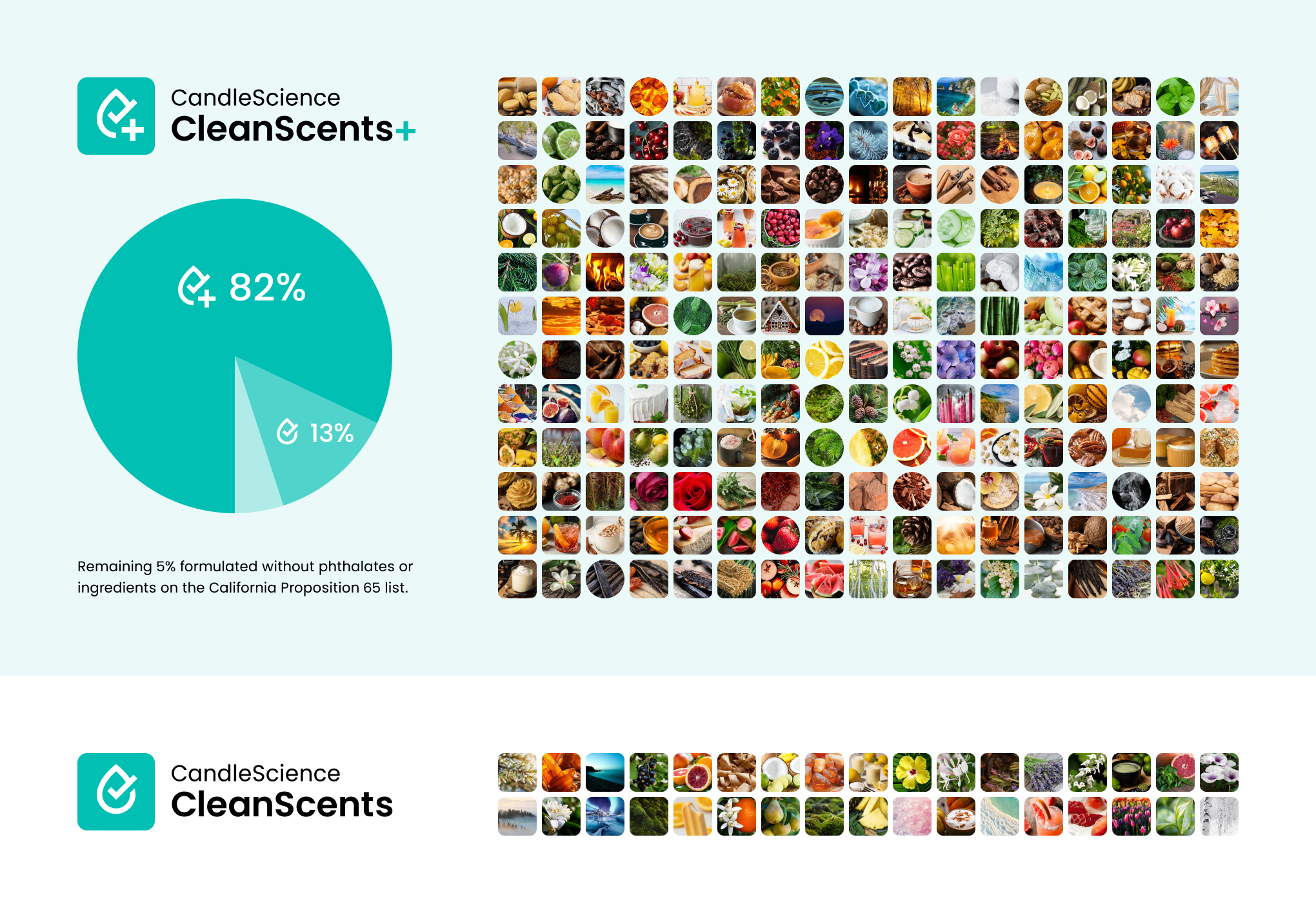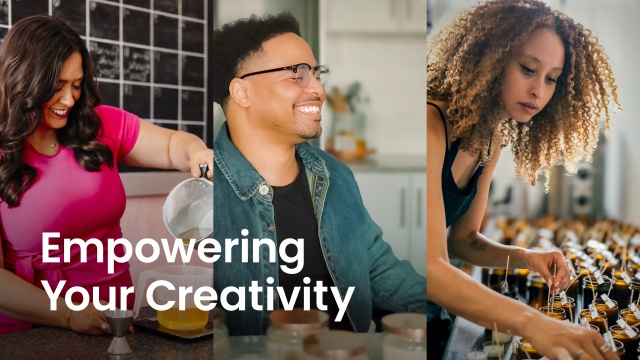CandleScience CleanScents® Program Overview A new approach to fragrance oil ingredient transparency
For nearly 10 years, we’ve committed to industry-leading openness so you can make scented creations with confidence and knowledge. From formulating fragrances without phthalates and ingredients on the California Proposition 65 list, to our original, groundbreaking in-house CandleScience CleanScents® Program, we’ve set new standards in how makers—and even other suppliers—think about fragrance.
Our enhanced CandleScience CleanScents Program brings even more clarity to makers as we balance safety, quality, and creativity. We’re dedicated to offering the best fragrance oils because you deserve nothing less.
Read all about the history of CleanScents® here

What's behind this new approach?
Once a year, the fragrance industry receives updates from the Research Institute for Fragrance Materials (RIFM), the international scientific authority for the safe use of fragrance materials. These updates flag ingredients as either suspected or confirmed carcinogens, mutagens, or reproductive toxins, collectively known as CMRs. RIFM then conducts further research on the suspected ingredients to determine their ultimate status.
The original CleanScents program—which avoided carcinogens, mutagens, acute toxins, reproductive toxins, and organ toxins—also treated suspected CMR ingredients as though they were confirmed. This choice then meant some of your favorite fragrance oils lost their CleanScents status based on suspicion alone, rather than scientific confirmation.
For example, gamma-Terpinene, a major component of essential oils made from citrus fruits, is a suspected CMR. In our original CleanScents program, the presence of this naturally occurring component in a fragrance oil would cause it to lose its CleanScents status. However, this is a natural ingredient, and we felt our customers may want more information to decide for themselves if they feel comfortable using it in their products.
Fragrance oils losing their CleanScents status led to very valid customer frustrations, which we heard and empathized with. We also didn’t have a clear way to communicate why a fragrance would lose its status. Motivated by our wish for increased transparency, and with flexibility for our customers in mind, our Product Development team began looking for better options.
The solution: CleanScents+® and increased ingredient transparency
To address these challenges and provide you with clearer choices, we’ve created a tiered system for classifying our fragrance oils with CleanScents+ and CleanScents designations.
There are three tiers to help you easily distinguish the options and choose which fragrance oils you’d like to use.
CleanScents+ is our highest fragrance oil safety standard and the original inspiration for our in-house regulatory program. These fragrances are manufactured without organ toxins, acute toxins, CMRs, phthalates, and ingredients on the California Prop 65 list.
CleanScents (without the +) fragrances contain one or more suspected, but not confirmed, CMR ingredients. They are manufactured without organ or acute toxins, phthalates, and ingredients on the California Prop 65 list. Each fragrance’s product page lists its suspected CMR ingredient(s) and links to more information. This allows you to make informed decisions about what ingredients are acceptable for your products.
Fragrances without a CleanScents designation comprise less than 5% of our library, but are all still made without phthalates nor ingredients on the California Proposition 65 list. Fragrances without a CleanScents designation are more likely to be discontinued, but that decision is based on sales and customer requests for reformulations.
This more detailed categorization allows us to continue prioritizing safety while offering you a full range of fantastic fragrance options. Have questions? Check out the CleanScents Program FAQ below.
CandleScience CleanScents® Fragrance Overview

Use the Fragrance Oil Finder to search for fragrances by tier!
The vast majority of CandleScience fragrance oils feature the CleanScents+ or CleanScents designations. CleanScents status will be updated on each product page as RIFM completes its research on ingredients.
CleanScents Program FAQ
CandleScience CleanScent+ and CleanScents fragrances have different logos—look at the logos on the fragrance product page. Examples are at the top of this article.
Product pages for CandleScience CleanScents fragrances include a list of ingredients immediately under the logo.
Fragrances without either designation have no logo on the product page or on the fragrance bottle.
The most up-to-date information about a fragrance’s status will always be shown on its product page.
These fragrances still exceed industry safety standards, especially when used with proper personal protective equipment (PPE) and ventilation. Non-CleanScents fragrances are high-performing fragrances that are formulated without phthalates, California Proposition 65 compliant, vegan, and cruelty-free.
If a fragrance only contains suspected CMRs—and is therefore still a CleanScents fragrance—the ingredient(s) in question will be noted on the product page, along with information on how to learn more about that ingredient. No CleanScents or CleanScents+ fragrances contain organ or acute toxins.
If a fragrance falls completely out of compliance with our CandleScience CleanScents Program, a list of components will always be available on each fragrance oil’s Safety Data Sheet.
Suspected ingredients are fragrance components that, due to emerging research, have potential safety concerns that require further investigation to fully assess their health and environmental impacts.
We launched a revision to our CandleScience CleanScents Program in October 2024 that includes transitioning to revised CleanScents logos. Please refer to fragrance oil product pages for correct CleanScents designations while this change is completed.
It depends! Blends made with only CleanScents+, or with CleanScents+ and CleanScents fragrances, can still be called CleanScents. CleanScents+ or CleanScents fragrances that are blended with other manufacturer oils cannot be marketed as CleanScents.
The Research Institute for Fragrance Materials (RIFM) is an independent, non-profit scientific research institute that conducts and publishes safety assessments of all ingredients used for their aroma-producing properties. RIFM’s work is evaluated by a panel of international experts in toxicology, dermatology, pathology, environmental, reproduction, and respiratory science with no ties to the fragrance industry. You can learn more about their research, safety assessment program, expert panel, and access their database here.
Questions about CleanScents+, CleanScents, or this tiered program? Our Customer Support team is here to help!
Our Mission
Make crafting with fragrance inspiring and joyful with quality products and innovative resources that support your creative journey.
We make crafting with fragrance simple and clear, offering expert guidance and tested products so you can create with confidence—whether you're a seasonal hobbyist or an established brand. This mission drives our commitment to supporting your creativity with expertise, inspiration, and ethical, reliable, and safe products
Learn more about our story.
